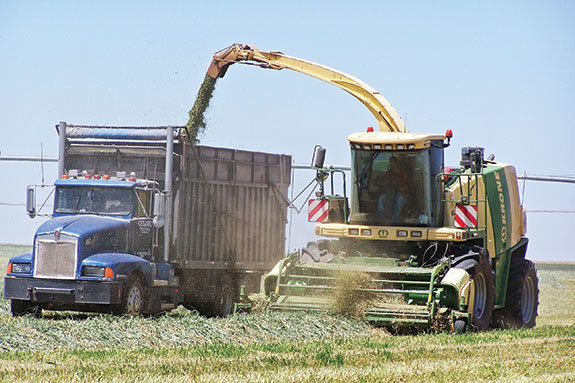All of these species have the potential to fill gaps between summer crops to supply year-round, high-quality feed to meet the constant and high nutritional demands of lactating dairy cows.
Many dairies will grow both summer and winter crops, often on the same piece of land in one year, in an effort to store as much feed as possible.In addition, growing the crops with the intent to sell to nearby dairies gives farmers a potentially more profitable alternative to grain harvest, depending on comparative crop market values.
Small grains also serve as excellent cover crops that help prevent soil erosion and can be used to take up significant amounts of soil nitrogen.
Nitrogen uptake is particularly important in green water, land application practices common with dairies in the West.
Below are some considerations for producers looking to take advantage of small grains, particularly for supplying dairy operations in the western U.S.
Crop selection
Is triticale better than wheat?
Wheat is the best dual-purpose small-grain crop that gives growers the greatest amount of flexibility with harvest and marketing options.
However, wheat has generally produced lower yields than triticale at a similar growth stage in trials conducted at Clovis, New Mexico.
Typical yields of wheat cut for silage (65 percent moisture) range from 10 to 15 tons per acre. Triticale has yielded greater than 15 tons per acre, and some varieties have produced as much as 20 tons per acre.
In addition, blends of wheat and triticale have performed better than wheat alone. Triticale has increased in popularity among forage growers looking for alternatives to wheat that may provide higher yields, nitrogen uptake and disease and insect resistance.
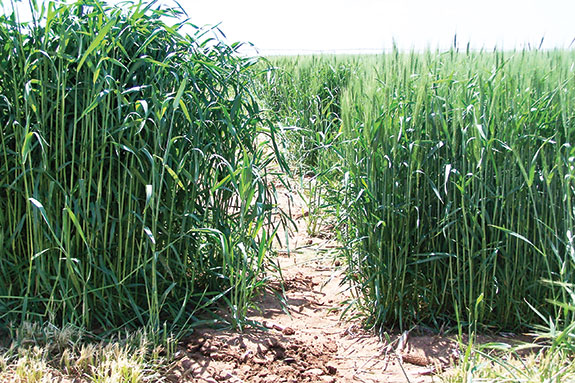
Triticale has a similar seasonal growth distribution to wheat but is later-maturing.
Because it is a cross of wheat with rye, there is a slight reduction of feeding value compared to wheat.
However, in-season management generally affects nutritive parameters more than anything.
Triticale has larger stems and heads than wheat and usually grows taller. As a result, triticale may require more wilting time at harvest.
What about barley?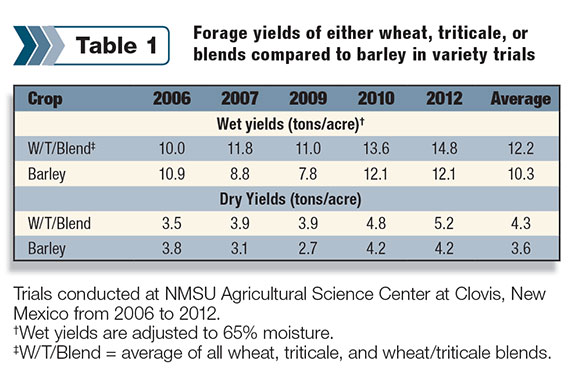
Historically, winter barley has been an inferior producer of forage when compared to wheat and triticale yields (Table 1).
On the other hand, barley produces the most nutritious forage of all the small-grain cereals.
It is lower in fiber and lignin and is characterized by high crude protein and total digestible nutrients (TDN). Feed value is often 90 to 100 percent of that of corn.
Although it produces high-quality hay and silage, TDN per acre is low due to its low tonnage. Irrigated trials at Clovis, New Mexico, have indicated that when compared with wheat, triticale and blends, barley competes better in dry situations than when rainfall or irrigation amounts are moderate to high.
Additionally, barley is the go-to small grain of choice in saline soils or where irrigation water quality is low due to excessive salts.
Production considerations
Planting
Small grains planted for forage (grazing, hay or silage) production should be planted at rates about 25 percent higher than what would be planted for grain.
For example, if a typical seeding rate for irrigated wheat grain in your area is 80 to 90 pounds per acre, then the corresponding forage rate would be about 100 to 120 pounds per acre.
By increasing seeding rate, stem size is reduced, nutritive value is improved, and plants will dry faster and compact easier for ensiling.
This is particularly true with triticale, where stems tend be relatively large. Yield increase should not be used as a reason for high seeding rates.
Very little improvement in forage yield has been observed with planting rates greater than 100 pounds per acre.
Soil fertility and plant uptake
Small grains respond well to nitrogen applications, and tillering for early forage production is promoted by adequate phosphorus.
Total nitrogen amounts will depend on residual soil nitrogen and intended use of the crop. General recommended rates are about 30 pounds N per ton of dry forage yield (10 to 12 pounds N per wet ton).
Split applications are advised, and the majority of nitrogen should be top-dressed in spring prior to reproductive growth stages.
Heavy applications of effluent water early in the fall and winter (when crop growth and uptake is minimal) can lead to plant lodging as well as significant amounts of N leached out of the root zone, where it is wasted or becomes an environmental concern.
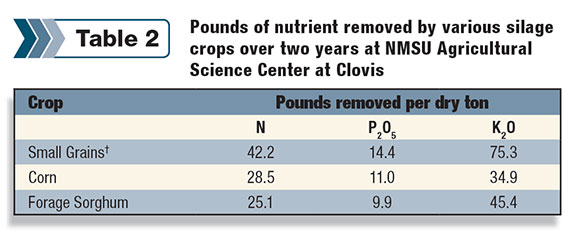
Nutrient uptake can be considerably higher in small grains compared to other silage crops such as corn and forage sorghum (Table 2).
This can be a benefit in situations where excess nitrogen and phosphorus need to be removed but could become a limiting factor where these nutrients must be supplied through inorganic applications.
Irrigation management
Total seasonal water requirements in small-grain forage systems typically range from 16 to 24 inches.
Early profile filling irrigations can be helpful in the spring in order to ensure adequate deep water just before rapid growth associated with jointing – and later growth stages when well capacities have a hard time keeping up with plant demand.
From jointing on, adequate moisture is essential and soil water availability should not be allowed to deplete below 50 percent.
Water use can be exceptionally high if plants are allowed to reach soft-dough stage, and producers should ensure their irrigation capacity is adequate enough to push for higher yields due to advancing maturity.
Harvest/nutritive value
Small grains cut at boot stage contain higher crude protein than corn and sorghum silages but often contain less energy.
Conventional wisdom says that late-boot or early-heading is the best time to cut for silage because energy and protein are optimized at this stage.
After heading, energy and protein decline and fiber and lignin increase. As the plant begins to fill grain, a slight recovery in energy occurs but not to the high level achieved at boot.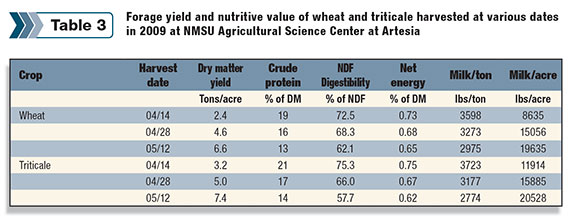
On the other hand, total crude protein, TDN and milk production per acre can be greatly increased by allowing the crop to mature to soft-dough stage (Table 3).
This is true because the increase in yield is enough to offset the decline in quality of the field.
Yields can be nearly doubled by allowing cereals to mature from boot to soft dough – if water is not limiting.
In the Southern High Plains, where average herd sizes exceed 2,000 head, producers may wish to maximize yield and TDN or milk per acre rather than achieve the highest quality possible at boot.
Wheat maintains its quality slightly better than triticale throughout maturity with respect to energy and fiber digestibility.
Small grains harvested at boot stage or earlier will have a moisture content of about 80 percent and will have to be wilted to a target moisture of 65 percent.
Small grains have hollow stems and can be more difficult to pack than corn and sorghum silages. Finer chopping and rapid silo or bunker filling, packing and covering are particularly important with small-grain silages.
In addition, potential benefits from inoculants are greater with small grain than for corn or sorghum silages because microbial populations are often low after winter, and this may be particularly important for crops cut early during cool periods.
Conclusions
The importance of small-grain forages will remain for years to come as animal operations demand a constant supply of feed, as summer droughts continue to shorten corn silage supplies, and as the year-round need to utilize liquid manure persists in some regions of the U.S.
Small grains have the potential to produce large amounts of nutritious forage for multiple uses. Knowing production and feed output goals is critical to proper crop selection, management, and utilization of these forages. FG
References omitted due to space but are available upon request. Click here to email an editor.
PHOTOS
PHOTO 1:Small grains harvested at boot stage or earlier will have a moisture content of about 80 percent and will have to be wilted to a target moisture of 65 percent.
PHOTO 2: Triticale has larger stems and heads than wheat and usually grows taller. As a result, triticale may require more wilting time at harvest. Photos courtesy of Mark Marsalis.
Mark Marsalis
Agronomy Specialist
New Mexico State University Ag Center
